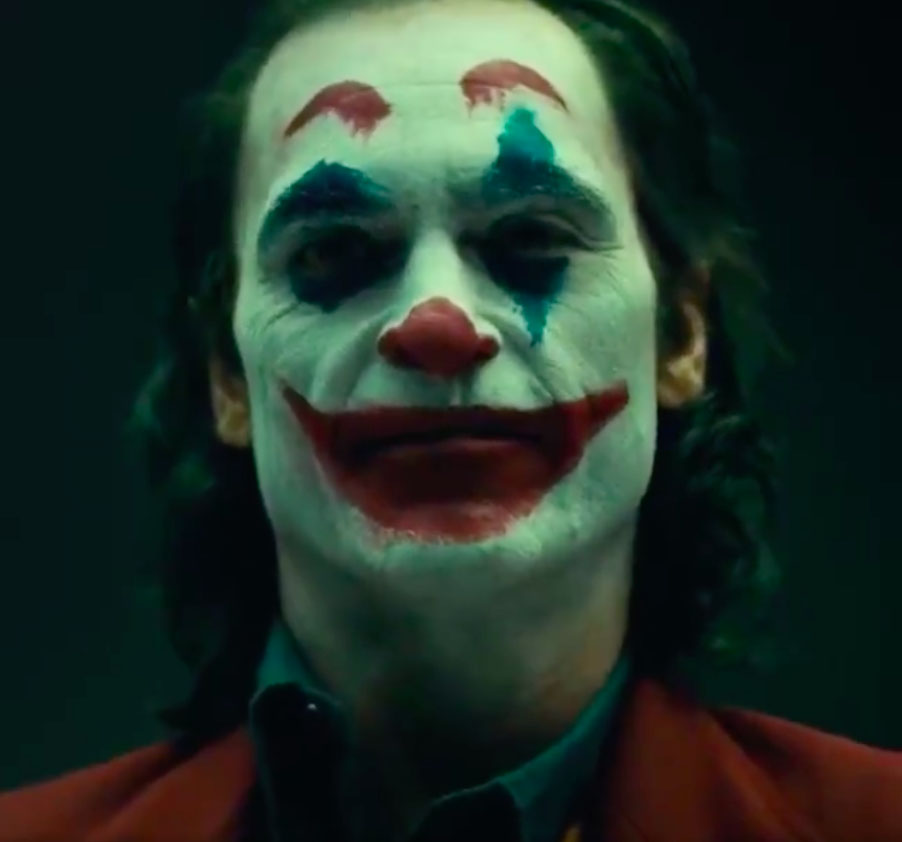
CAUTION SPOILERS CAUTION SPOILERS
Where to start with this film. Hyped by the media and local news as a disturbing film prone to give disturbed people bad ideas. Local police beefed up their presence around local theaters in certain areas. Yes this movie has some violence, but I wonder if anyone is going to alert the authorities when Rambo hits the cinema. As comic book movies go I’d say it’s really good, defiantly holding it’s own against other R rated movies like Logan. Really it seems like a cautionary tale about the breakdown of the mental health industry.
Portrayed exquisitely By Joaquin Phoenix and directed by Todd Philips. Joker is the story of Arthur Fleck a broken every man and his descent into total madness. This film would be hard to make for anyone due to all of the lore and obsession surrounding this character in the DC universe. A cleverly written back story by Todd Philips and Scott Silver as well as stunning cinematography by Lawrence Sher offset the heavy subject matter to create a great film that treats the subject matter with the respect it deserves.
Here is a man who would not take it anymore. Oh wait sorry that is Taxi Driver, which Joker borrows heavily from. Several scenes show Arthur Fleck pointing to his head making the gun gesture from the final scene in Taxi Driver. But I am getting ahead of myself. Arthur Fleck is having a bad day or heck let’s say a bad life which also borrows from the premise of another film called Falling Down staring Michael Douglas. Part of the fun of this film is spotting the numerous references to other cinema greats. Remember greatness is knowing who to borrow from.
The film begins with Arthur in clown make up pulling his face into distorted frowns and smiles basically setting the scenes for act I and act II of the film. Arthur has to see a court appointed under budgeted city therapist, who shows no real concern for Arthur as a human being but more as a time block. Paying general lip service to his issues and not really hearing him and his plight. He begs for higher dosages in his medication to numb out all his feelings because all his thoughts are negative thoughts. At home we see Arthur taking care of his ailing mother who seems obsessed with Thomas Wayne as well as having obvious mental issues of her own. Further adding fuel to the fire Arthur takes a beating from some local street hoods which begins his spiral down into madness. One horrible event after another builds and builds with in him until he is overwhelmed and pushed over the edge.
Here is where other film reviewers pointed out the danger of the “angry white man” but Arthur’s dilemma could just as easily been anybody else if given the right circumstances or portrayed by any other actors of any nationality or gender. To make this a race or gender thing seems like lazy journalism, who among us can truly say that stress doesn’t play havoc with reality from time to time. To be fair Arthur does handle his problems in an ultra violent way. After taking his second beating this time from Wall Street drunks Arthur defends himself with a shady gun given to him by a co worker. His actions aggravate the tensions already felt by the downtrodden population of Gotham City who take up the clown mantle as a symbol of their class warfare rage. Now let’s play with the story here if Arthur’s character was being played by Stallone, Schwarzenegger, The Rock, or Vin Diesel then I think no one would have any issues. However because Phoenix’s Joker is gaunt, unattractive, mentally ill, and lacking the roided out sex appeal as well as catch phrases like “wait til they get a load of me” or “why so serious” he becomes more real and therefore more feared. I don’t remember hearing of any extra police being assigned to the Death Wish reboot that Bruce Willis so clumsily starred in recently about a man who takes the law into his own hands with extreme prejudice.
Let’s be clear this review is not a condoning the Joker’s behavior. Violence of this kind is not the solution but merely for Arthur is the logical self destruction of his own fragile reality. Several times during the film we see Arthur ready to commit suicide, which for some reason got some laughs from both audiences during the first and second viewing. This to me seems to be the most disturbing and telling aspect of the film. It is a mirror into the current state of mind the audience projects when this type of mental illness is presented to them.
As for this take on the Joker Todd Philips along with Scott Silver use some clever new devices to explain how this Joker ticks. Traditionally the Joker has been depicted with having a psychotic laugh that chills his enemies to the bone. In this version we have the laugh, still creepy, but as a result of head trauma suffered at an early age. Here at the beginning the soon to be Joker is a broken shell of a man. Haunted by delusions of a normal life he will never have. Deep fantasies of a relationship with a female neighbor a few doors down, to becoming a famous stand up comedian bring as much pleasure as they do pain to his fragmented psyche. At no time do we see the clown prince of crime super intellect endowed in other films and comics. From the beginning through the middle we see Arthur’s character uncontrollably laughing as a response to nerves or embarrassment. After committing several murderous atrocities we see his laugh start to disappear as he begins to accept and embrace the new side of himself. After the violence we see Arthur engage in an almost ritualistic dance, possibly based on Tai Chi he may have learned in the mental ward he was committed to referenced earlier in the film. Each time Arthur commits a murder we see him bathed in bright light as if he is stepping out onto the “stage”.
Other new ideas present themselves in the form of Thomas Wayne usually depicted as a saint of a man, brought down to earth as a hard nosed businessman. Cold to the population with tough words for the city’s poor and out of work. Philips also plays with the idea of Arthur somehow being Thomas Wayne’s illegitimate son. Arthur inappropriately pays a visit to Wayne manor and has a brief moment with a young Bruce Wayne. Perhaps this small exchange rattles around deep in the back of Bruce’s mind and is the reason he cannot kill the Joker. This rumor is dispelled by Thomas Wayne himself as he violently attacks Arthur in a cinema bathroom telling him “if you come near my son again I’ll kill you”. After his altercation with Thomas Wayne Arthur breaks into his “imaginary” girlfriend’s apartment and his phony relationship is exposed for the fraud it is. Uttering the line “I’ve had a really bad day” (Falling Down) and following up with the pistol finger gesture from Taxi Driver. Even the score seems to loosely mimic the Taxi Driver scene. Searching out his mother’s old medical records Arthur reaches his final breaking point. Finding out that he was adopted and abused as a child Arthur murders his mother who is in the hospital recovering from a stroke. With nothing from his former life to tether him to reality the Joker persona finally emerges in it’s full form.
Earlier in the film we saw Arthur trying his best to create a stand up comedy career for himself. He tries to perform only to succumb to his severe anxieties. The stand up routine has shades of Andy Kaufman, who purposely led with awkwardness to play with the audience’s reality. While this is not Arthur’s plan one can’t help but see a glimmer here. Arthur has delusions of meeting a Johnny Carson style talk show host portrayed by Robert DeNiro. Again the Scorsese references abound. DeNiro played in the 1982 film King Of Comedy about an untalented comedian who kidnaps his idol as part of a delusional fantasy. If your going to be influenced by another director Martin Scorsese is tough to beat. DeNiro’s character Murray Franklin finds out about Arthur’s stand up and shows it live on his show shattering the one good dream Arthur has left. As the film progresses and Arthur begins to give himself to the Joker, Murray Franklin invites him to be a guest on his show. After viciously murdering the old co-worker who gave him the gun that started this whole trip down the rabbit hole. The Joker is now complete. When Arthur traveled to and from work we saw him climbing a particular set of stairs. Each step felt as thought it carried the tremendous weight of every slight and embarrassment. Here at the end we see the Joker dancing down each step light as a feather in a sort of demented Saturday Night Fever strut. A police chase ensues and we see the Joker run for his life only to end up in a subway car full of other clowns. Evading the police the Joker enters his final phase.
Sitting in the green room Arthur finally meets his idol Murray Franklin. Also present is Murray’s producer played by Marc Maron. Murray asks Arthur about the face paint wondering if it’s political, to which Arthur replies “I don’t believe in anything” which is a wink to the agent of chaos style Heath Ledger famously portrayed. As Murray turns to leave we finally hear Arthur ask to be introduced as Joker. All bets are off at this point. Murray announces the Joker we see him confidently and suavely glide across the stage, even kissing the Dr. Ruth esque character shocking the audience. During the exchange between Murray and the Joker it is revealed that the Joker is responsible for the wall street murders that spearheaded the kill the rich riots. We hear the Joker say” do I look like the kind of clown who could start a movement” again hearkening back to Heath Ledger’s Joker. At this point the Joker assassinates Murray before the live TV audience. This causes total chaos which is the signature Joker we all know. In the last Scorsese influenced scene we see the Joker being arrested and being transported by police via squad car all the while listening to Cream’s White room in all it’s mob style glory. The scene winds down with the death of Bruce Wayne’s parents and the Joker dancing like the devil surrounded by demon minions. A true agent of chaos.
In the post scene we see the Joker without make up in an attempt to bring Arthur back. He is speaking with the same therapist from the beginning of the film. The Joker begins to laugh to himself, and when asked to share the joke he replies “you wouldn’t get it”. The final shot see the Joker leaving the room with bloody foot prints and ends with a deranged homage to Charlie Chaplin and The Keystone Cops. The moral of this story is be nice to every one because you never know who might have the last laugh.
Dave Dembitsky
Contributing Writer/Film Editor at Custom Made Music







